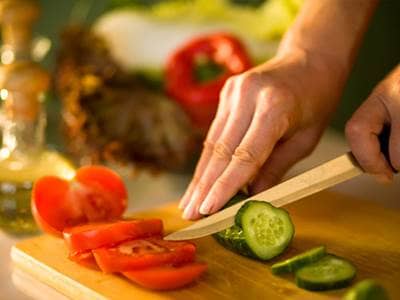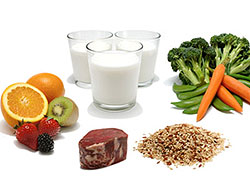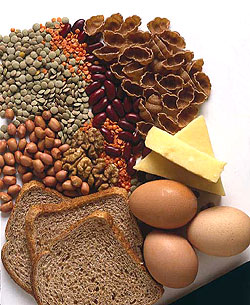So what do you think? Is Chocolate a health food; or is it the devil’s own temptation? So to speak. Over the years I’ve tried most of the diets out there. From extreme deprivation, to see food and binge on it… Usually the extreme deprivation bit led to the see food and binge on it result.
Personally, I no longer do the off the wall totally eliminate this food or that food bit. The only time I will be living on solely one food or the other to the elimination of another food, or food group, (as in real food) is if that food is not available or I can not access it. Various foods do not trigger binges. Unresolved issues trigger binges. Stress over loads trigger binges. If you starve yourself you are more than likely to stuff anything and everything you can get your hands on in your mouth. Plus your body will store away every calorie it can. Is your body doing a bad thing? No, it is trying to survive.
You want to be healthy? Eat when you are hungry. Eat the best quality you can. Moderation and variety are the key words here. Oh and lets not forget real food. Is chocolate a real food. Yes darlin, it is. That is, if it is actually real chocolate and not some artificial flavoring crap. Read the labels. Don’t understand what’s on there? Get online and do some research.
It’s not as complicated as the sales people like to make it sound. Yes I got sucked into all the hype too. Over and Over; I might add.
You are not obese because you ate a chocolate bar. If you are obese, or starving yourself, either way actually, there are psychological issues you seriously need to contend with. One day, one step at a time.
I’m running out of time so I’m wrapping this note up. Heading out the door to mow down some thigh high grasses and weeds the rain has blessed us with. I live out on a ranch and need to knock these things down around my dog yards corrals and out buildings. Going to start cutting a fire break as well.
I came across the following article on Active.com. It is well worth the read, enjoy.
Life is a journey, enjoy the trip.
Mary E. Robbins
Robbins Run Ranch: In Wild Wonderful Wyoming
307.788.0202
By Nancy Clark
******
By
Nancy Clark, MS RD CSSD
For Active.com
"Chocolate: I try to stay away from it," commented my client, a runner who described herself as having a rampant sweet tooth. For her, chocolate fits into the categories of junk food, guilty pleasure and ruiner of good intentions to lose weight. Yet, she also recognized there is potentially a happier side of the story. Ads for (dark) chocolate suggest chocolate is good for us. Chocolate comes from plants and contains the same health-protective compounds that are found in fruits and vegetables.
So what is the whole story on chocolate? Is it little more than an alluring form of refined sugar, saturated fat and empty calories? Or does chocolate (in moderation, of course) have positive qualities that might be beneficial for athletes?
Here are some nuggets of information about chocolate. I'll let you decide whether the health benefits of eating chocolate are greater than the health costs—and if you personally want to define chocolate as a "health food" within the context of your own sports diet.
The "Bad"
The bad news is chocolate consists of primarily saturated fat and sugar. A Hershey's Chocolate Bar (43 g) contains 210 calories, 24 grams sugar (46 percent of calories), 13 g total fat (55 percent of calories) and 8 g saturated fat, equivalent to a tablespoon of butter. Boo hoo. (But here's how you can rationalize including this popular treat in your overall well-balanced sports diet: The fat in chocolate does not raise bad cholesterol levels and the sugar (carb) in chocolate fuels your muscles...)
People tend to eat chocolate in bursts—a lot in a day, such as on holidays or pre-menstrually—or none. The question arises: Would enjoying some chocolate every day help reduce an athlete's urge to binge-eat the whole bag of, let's say, M&Ms in a moment of weakness? That's a good question and one that needs to be researched. We do know that deprivation and denial of food contributes to overeating. You know the syndrome: “I'm starting my diet Monday morning, so Sunday is my last chance to eat chocolate...” and there goes the whole bag of M&Ms.
I invite my clients to try taking the “power” away from chocolate by enjoying a little bit every day, such as for dessert after lunch. Ideally, daily chocolate could reduce it to being simply a commonplace plant food, just like bran cereal, an apple or carrot sticks. Give it a try?
The "Ugly"
Some athletes claim they are "addicted" to chocolate. Perhaps "chocolate addicts" grew up in a household where the parents banned chocolate? Now, as grown-ups, maybe they rebel by eating Reese's Pieces by the bagful? Or are they’re “super tasters”—and the flavor of chocolate is just irresistible? Perhaps they have a genetic difference that makes chocolate highly attractive? Some day, genetic testing may help us find the answer to that question.
The "Good"
Chocolate is made from cocoa. Cocoa comes from a plant and is a rich source of health-protective phytochemicals, just like the kind you get from fruits, vegetables and whole grains. Two tablespoons natural cocoa power (the kind used in baking) offers the same antioxidant power as 3/4 cup blueberries or 1.5 glasses red wine.
Of all the types of chocolate, dark chocolate is the richest source of phytonutrients. Unfortunately, dark chocolate has a slightly bitter taste and most people prefer the sweeter milk chocolate. Maybe we should raise today's children on dark chocolate, so they will they learn to prefer it.
One phytochemical in cocoa is nitrate. Nitrate gets converted into nitric oxide, a chemical known to increase blood flow. Nitric oxide lowers blood pressure, a good thing for aging athletes who want to stay youthful and invest in their health. (1)
Another group of phytochemicals are called flavonoids. They are in many plant foods, including tea, apples and onions. Epidemiological surveys of large groups of people indicate those who regularly consume chocolate consume more of these health-protective flavonoids than non-chocolate eaters. This reduces their risk of heart disease. In the Netherlands, elderly men who routinely ate chocolate-containing products reduced their risk of heart disease by 50 percent and their risk of dying from other causes by 47 percent. (2)
Cocoa increases blood flow to the brain. If this means you can process information better and faster—like calculate your split times or help your kids with their math homework—wouldn’t that be a great excuse to enjoy chocolate?
Many parents keep chocolate away from their children, thinking chocolate makes them hyper. No research to date supports that claim. The party or special event that surrounds the chocolate likely triggers the hyperactivity. (3)
Chocolate is yummy. Most athletes love chocolate. Chocolate lovers don't want sugar-free or fat-free chocolate. They want the 100 percent real stuff. That's because consumers buy benefits, not products. Being yummy is a huge benefit.
During the recession in 2009, sales of Hershey's chocolates increased. Is that because worried people bought a moment of yummy, cheer-me-up chocolate? Or, did they simply settle for a bag of less expensive Hershey's Kisses instead of a box of pricey Godiva Chocolates? Regardless, chocolate seems to fit every mood—be it happy, sad, tired or celebratory.
Flavanol-rich cocoa may help reduce muscle soreness. Studies with athletes who performed muscle-damaging downhill running and then consumed a cocoa-based carbohydrate and protein beverage experienced less muscle damage and felt less muscle soreness. (4)
Although the chocolate used in flavoring milk lacks the health-protectors found in dark chocolate, the yummy flavor makes chocolate milk a popular recovery drink. The sweetened chocolate offers carbs to refuel muscles; the milk offers protein to build and repair muscle. Plus, milk boosts intake of calcium and vitamin D, needed for strong bones.
Conclusion
Despite all this good news about chocolate, it is still just a candy and not a life-sustaining food. Yet, it does provide pleasure—and pleasure is certainly part of a health and wellness program, right?
The trick is to enjoy dark chocolate as part of the 100 to 150 “discretionary” sugar calories that can be part of your daily sports diet. As for me, I'll enjoy my dark chocolate during a long hike or bike ride. It tastes better than most engineered sports foods and nicely fuels both my body and my mind.
Chocolate Lush
This low-fat brownie pudding forms its own sauce during baking. It’s a tasty treat for when you are hankering for a chocolate fix and a yummy way to add a little dark chocolate to your sports diet. This recipe is one of many in my
Sports Nutrition Guidebook.
- 1 cup flour,preferably half white, half whole wheat
- 3/4 cup sugar
- 2 tablespoons unsweetened dry cocoa
- 2 teaspoons baking powder
- 1 teaspoon salt
- 1/2 cup milk
- 2 tablespoons oil, preferably canola
- 2 teaspoons vanilla
- 3/4 cup brown sugar
- 1/4 cup unsweetened dry cocoa
- 1-3/4 cups hot water
Optional: 1/2 cup chopped nuts.
1. Preheat the oven to 350°.
2. In a medium bowl, stir together the flour, white sugar, 2 tablespoons cocoa, baking powder, and salt; add the milk, oil, and vanilla. Mix until smooth. (Add nuts.)
3. Pour into an 8x8" square pan that is nonstick, lightly oiled, or treated with cooking spray.
4. Combine the brown sugar, 1/4 cup cocoa, and hot water. Gently pour this mixture on top of the batter in the pan.
5. Bake at 350° for 40 minutes, or until lightly browned and bubbly.
Yield: 9 servings
Total calories: 2,100
- Calories per serving: 230
- Nutrients percent Grams
- Carbohydrate 46 grams
- Protein 3
- Fat 4






























 Term "
Term " Standard body weight scales provide a measure of total weight, but don't determine the lean-to-fat ratio of that weight. Standing on most scales can tell you only if you weigh more than the average person, but not if that weight is fat or muscle. Based only on scale weight, a 250-pound athlete with 8% body fat may be considered "overweight" by a typical weight chart. Such charts are not a good indication of ideal body weight for general
Standard body weight scales provide a measure of total weight, but don't determine the lean-to-fat ratio of that weight. Standing on most scales can tell you only if you weigh more than the average person, but not if that weight is fat or muscle. Based only on scale weight, a 250-pound athlete with 8% body fat may be considered "overweight" by a typical weight chart. Such charts are not a good indication of ideal body weight for general  To keep muscle but slowly lose fat, you have to consume plenty of
To keep muscle but slowly lose fat, you have to consume plenty of  KEEP YOURSELF WELL-HYDRATED. Always keep well-hydrated with
KEEP YOURSELF WELL-HYDRATED. Always keep well-hydrated with 
 CYCLE YOUR CARBOHYDRATE INTAKE. Being on a low-carbohydrate diet for prolonged periods of time will deplete your glycogen stores and slow your metabolism. At least once a week, eat a high-carbohydrate meal consisting of mainly complex carbohydrate. This will help restore your glycogen levels with very little likely to be stored as fat. The recommended daily allowance (RDA) is 300 grams of carbohydrate per 2000 calories (about 60% of total calories). Regardless of the type of carbs you eat, all are treated the same way in your body--they are all broken down into sugars during digestion. But, complex carbohydrate are almost always the best choice because they are naturally low in
CYCLE YOUR CARBOHYDRATE INTAKE. Being on a low-carbohydrate diet for prolonged periods of time will deplete your glycogen stores and slow your metabolism. At least once a week, eat a high-carbohydrate meal consisting of mainly complex carbohydrate. This will help restore your glycogen levels with very little likely to be stored as fat. The recommended daily allowance (RDA) is 300 grams of carbohydrate per 2000 calories (about 60% of total calories). Regardless of the type of carbs you eat, all are treated the same way in your body--they are all broken down into sugars during digestion. But, complex carbohydrate are almost always the best choice because they are naturally low in  GET YOUR FIBER.
GET YOUR FIBER.  DO CARDIO ON AN EMPTY STOMACH FIRST THING IN THE MORNING. Just doing a cardiovascular (or aerobic) type of activity, such as riding a
DO CARDIO ON AN EMPTY STOMACH FIRST THING IN THE MORNING. Just doing a cardiovascular (or aerobic) type of activity, such as riding a 










